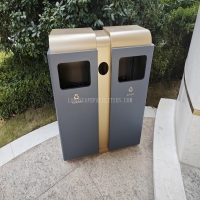Welcome to the website for landscape facilities products and knowledge.
How do climate and regional weather patterns influence the choice of materials for landscape bar counters?
The selection of materials for landscape bar counters is a critical design decision deeply intertwined with local climate and prevailing weather patterns. Unlike interior surfaces, these outdoor installations face constant exposure to environmental elements, making material durability and performance paramount considerations for architects and designers.
In regions characterized by intense sun exposure and high UV radiation, material selection prioritizes UV resistance to prevent fading, warping, and degradation. Composite materials, certain dense hardwoods like Ipe or Teak treated with UV-inhibitive sealants, and UV-stabilized polymers have become preferred choices. These materials maintain their structural integrity and aesthetic appearance despite prolonged sun exposure, whereas untreated woods or certain plastics would quickly deteriorate.
Humidity and precipitation patterns significantly influence material choices. In tropical and high-humidity climates, the resistance to moisture absorption, mold, and mildew is crucial. Materials such as marine-grade stainless steel, powder-coated aluminum, and non-porous stones like granite or quartzite excel in these conditions. Their inherent properties prevent water damage, rust, and the growth of organic matter, ensuring longevity and hygiene. Conversely, in arid climates, materials must withstand extreme heat and potential thermal expansion without cracking, making thermal mass materials like concrete or stone ideal for their ability to absorb and slowly release heat.
Temperature fluctuations present another major challenge. In areas with significant seasonal shifts and freeze-thaw cycles, materials must have low water absorption rates to prevent cracking from internal ice expansion. Porcelain tiles, certain engineered quartz surfaces, and properly sealed concrete are excellent for freeze-thaw resistance. Materials that absorb water, like some natural stones or unsealed wood, can suffer catastrophic failure in these environments.
Coastal regions introduce the corrosive element of salt spray. Here, standard metals will quickly corrode. The material palette shifts dramatically toward aluminum, stainless steel (particularly grade 316 marine stainless), and specially treated brass or copper. Even hardware and fasteners must be selected for corrosion resistance to ensure the entire structure's integrity.
Beyond pure durability, climate also influences tactile and comfort-based choices. In hot climates, materials that remain cool to the touch, such as stone or tile, are often preferred. In cooler climates, designers might incorporate sections of thermally modified wood or composite materials that feel warmer, enhancing user comfort.
Ultimately, a successful landscape bar counter is not just an aesthetic object but a testament to a designer's understanding of its environmental context. The most appropriate material is one that harmonizes with the local climate, ensuring the structure is not only beautiful upon installation but remains functional, safe, and visually appealing for years to come, withstanding the specific weather patterns it will inevitably face.
Related search:

Recommendation
Double-bucket garbage bin, outdoor, metal, multi-color, powder-coated, double-bucket trash can